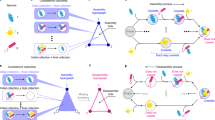Abstract
We address the question of the long term coexistence of three interacting species whose dynamics are governed by the ordinary differential equations x i = X i f i (i = 1, 2, 3). In order for any theory in this area to be useful in practice, it must utilize as little information as possible concerning the forms of the f i , in view of the great difficulty of determining these experimentally. Here we obtain, under rather general conditions on the equations, a criterion for judging whether the species will coexist in a biologically realistic manner. This criterion depends only on the behaviour near the one or two species equilibria of the two dimensional subsystems, the behaviour there being relatively easy to examine experimentally. We show that with the exception of one class of cases, which is a generalization of a classical example of May and Leonard [21], invasibility at each such equilibrium suitably interpreted is both necessary and sufficient for a strong form of coexistence to hold. In the exceptional case, a single additional condition at the equilibria is enough to ensure coexistence.
Similar content being viewed by others
References
Addicott, J. F.: A multispecies aphid-ant association: Density dependence and species-specific effects. Can. J. Zool. 57, 558–569 (1979)
Amann, E., Hofbauer, J.: Permanence in Lotka-Volterra and replicator equations. To appear in: Lotka-Volterra Approach in Dynamic Systems. Proc. Conf. Wartburg G.D.R. Berlin: Akademieverlag 1984
Arneodo, A., Coullet, P., Tresser, C.: Occurrence of strange attractors in three-dimensional Volterra equations. Physics Letters 79A, 259–263 (1980)
Bates, H. W.: Contributions to an insect fauna of the Amazon Valley. Lepidoptera: Heliconidae. Trans. Linn. Soc. London 23, 495–566 (1862)
Birkhead, T. R.: The effect of habitat and density on breeding success in the common guillemot (Uria aalge). J. Anim. Ecol. 46, 751–764 (1977)
Caswell, H.: Predator mediated coexistence: a non-equilibrium model. Am. Nat. 112, 127–154 (1978).
Freedman, H. I., Waltman, P.: Mathematical analysis of some three-species food-chain models. Math. Biosci. 33, 257–276 (1977).
Feedman, H. I., Waltman, P.: Persistence in models of three interacting predator-prey populations. Math. Biosci. 68, 213–231 (1984)
Harrison, G. W.: Global stability of predator-prey interactions. J. Math. Biol. 8, 159–171 (1979)
Hirsch, M. W., Smale, S.: Differential Equations, Dynamical Systems, and Linear Algebra. New York: Academic Press 1974
Hofbauer, J.: General cooperation theorem for hypercycles. Monatsschr. Math. 91, 223–240 (1981)
Hutson, V., Vickers, G. T.: A criterion for permanent coexistence of species, with an application to a two-prey one-predator system. Math. Biosci. 63, 253–269 (1983)
Hutson, V.: Predator mediated coexistence with a switching predator. Math. Biosci. 68, 233–246 (1984)
Hutson, V.: A theorem on average Liapunov functions. Monatsschr. Math. (in press)
Hsu, S. B.: On global stability of a predator-prey system. Math. Biosci. 39, 1–10 (1978)
Inouye, D. W.: The ecology of nectar robbing. In: Bentley, B., Thomas, E. (eds.) The Biology of Nectaries. New York: Columbia Univ. Press 1983
Lewontin, R. C.: The effects of population density and composition on viability in Drosophila melanogaster. Evolution 9, 27–41 (1955)
May, R. M.: Stability in multispecies community models. Math. Biosci. 12, 59–79 (1971)
May, R. M.: Stability and Complexity in Model Ecosystems. Princeton: Princeton Univ. Press 1974
May, R. M.: Theoretical Ecology: Principles and Applications. Oxford: Blackwell 1981
May, R. M., Leonard, W. J.: Nonlinear aspects of competition between three species. SIAM J. Appl. Math. 29, 243–253 (1975)
McGeehee, R., Armstrong, R.: Competitive exclusion. Am. Nat. 115, 151–170 (1980)
Murdoch, W. W., Oaten, A.: Predation and population stability. Adv. in Ecological Res. 9, 2–131 (1975)
Parrish, J. D., Saila, S. B.: Interspecific competition, predation, and species diversity. J. Theoret. Biol. 27, 207–220 (1970)
Randall, J. E., Randall, H. A.: Examples of mimicry and protective resemblance in tropical marine fishes. Bull. Mar. Sci. Gulf & Caribbean 10, 444–479 (1960)
Sigmund, K., Schuster, P.: Permanence and uninvadibility for deterministic population models. In: Schuster, P. (ed.) Stochastic Phenomena and Chaotic Behaviour in Complex Systems, pp. 173–184. Springer Series in Synergetics, vol. 21. Berlin-Heidelberg-New York: Springer 1984
Smith, B. H.: Demography of Floerka proserpinacoides, a forest floor annual III. Dynamics of seed and seedling populations. J. Ecol. 71 413–425 (1983)
Soberon, J. M., Martinez del Rio, C.: Cheating and taking advantage in mutualistic associations. In: Boucher, D. H. (ed.) The Biology of Mutualism: Ecology and Evolution. Croom Helm 1985
Vandermeer, J. H., Boucher, D. H.: Varieties of mutualistic interaction in population models. J. Theoret. Biol. 74, 549–558 (1978)
Way, M. J., Cammell, M.: Aggregation behaviour in relation to food utilization by aphids. In: Watson, A. (ed.) Animal Populations in Relation to their Food Resources. Oxford, Blackwell, 1970
Wickler, M.: Mimicry in Plants and Animals. London: Weidenfeld and Nicolson, 1968
Author information
Authors and Affiliations
Rights and permissions
About this article
Cite this article
Hutson, V., Law, R. Permanent coexistence in general models of three interacting species. J. Math. Biology 21, 285–298 (1985). https://doi.org/10.1007/BF00276227
Revised:
Issue Date:
DOI: https://doi.org/10.1007/BF00276227




